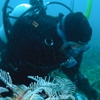General Description
Colony of individual polyps (hydranths) joined by root-like network of tubular stolons at the base. Colony shape is tree-like or bushy (arborescent). Colour: colony pale greenish to honey brown, often pink from a thin coating of coralline algae. Up to 25 cm high.
Biology
Colonies of this species grow during winter and early spring.
Habitat
Rubble sea floor in open areas with strong current flow.
Reefs
Distribution guide
Worldwide in temperate oceans, including southern Australia.
Species Group
Depth
Water Column
Max Size
25 cm
Diet
Plankton or Particles
Harmful
Generally not harmful but still able to sting bare skin.
Commercial Species
No
Global Dispersal
Recorded in Australia
Identify
Conservation Status
- DSE Advisory List : Not listed
- EPBC Act 1999 : Not listed
- IUCN Red List : Not listed





